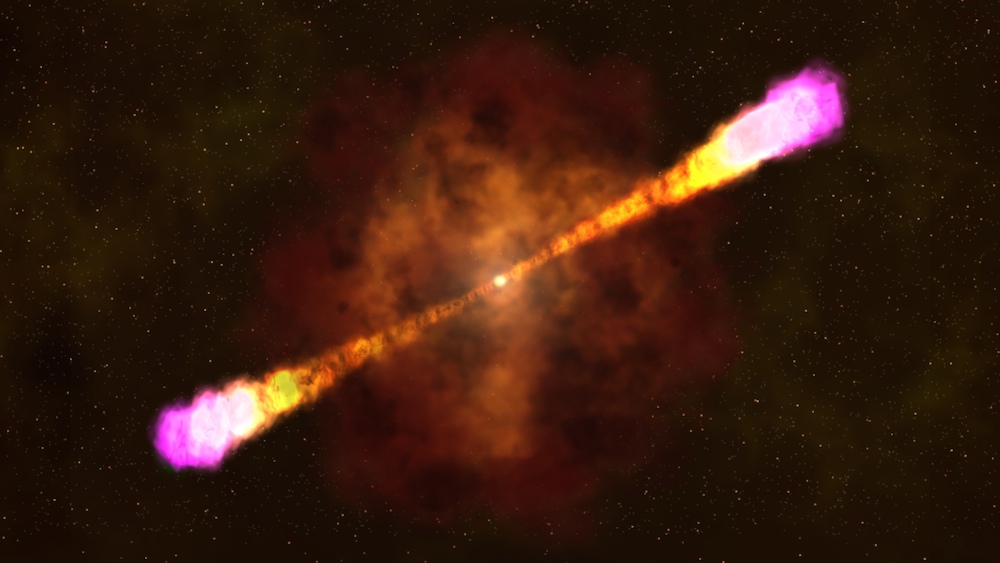Distant Galaxies' Explosions Become Psychedelic Songs

An astronomer and a graphic artist have teamed up to turn powerful explosions in distant galaxies into spellbinding music and animations. The unique celestial compositions are psychedelic and strangely beautiful.
Known as gamma-ray bursts, these explosions of high-frequency electromagnetic radiation are the brightest events known to occur in the universe. Sylvia Zhu, a graduate student in physics at the University of Maryland, College Park, studies gamma-ray bursts at NASA's Goddard Spaceflight Center in Greenbelt, Maryland, using the Fermi Gamma-ray Space Telescope.
"I figured it would be fun to 'hear' what these explosions might sound like, if we converted each photon into a musical note," Zhu told Live Science. [See animation of what a gamma-ray burst "sounds" like]
Turner Gillespie, an art student at the Maryland Institute College of Art, in Baltimore, started working with Zhu this summer to develop animations to go along with the cosmic music.
While gamma-ray bursts remain mysterious, scientists theorize that the deaths of massive stars and the mergers of dense objects, such as black holes and neutron stars, may produce these brilliant cosmic eruptions.
The bursts begin with an initial bright flash of gamma rays, known as the "prompt emission." This flash can last for a few milliseconds to several minutes, followed by an "afterglow" made up of less-energetic electromagnetic emissions including X-rays, visible light and radio waves. This part of the explosion can last anywhere from a single day to many months.
In April 2013, Zhu was part of a team that detected one of the brightest gamma-ray bursts ever seen. The astronomers spotted the celestial explosion, known as GRB 130427A, using the Fermi telescope and NASA's Swift Space Telescope.
Sign up for the Live Science daily newsletter now
Get the world’s most fascinating discoveries delivered straight to your inbox.
The enigmatic bursts don't really make a sound, but Zhu dreamed up the idea of converting them into music after learning of a similar project that sonified solar flares— brief eruptions of high-energy radiation from the sun.
To create the cosmic tunes, Zhu converted the gamma-ray signals detected by the Fermi telescope into notes on musical instruments. Gillespie interpreted the sounds to create abstract animations. The complete composition, which contains four movements, resembles "Fantasia," if it were set to cats walking on musical instruments.
The piece opens with a few haphazard jazz notes on acoustic bass and piano, as lines and flashing dots dance across the screen. Then the percussion bursts in, with drums and symbols animated as intersecting lines and misshapen ripples. Next follows some eerie synthesizer music accompanied by hypnotic visualizations. The piece ends with an orchestral movement featuring strings, harp and short violin, depicted as droplet shapes and curving lines.
"There are great moments where it is almost overwhelming for the viewer to pay attention to everything that is happening on the screen," Gillespie told Live Science. The chaotic animations resemble a gamma-ray burst itself, "an event almost impossible to comprehend," he added.
Gillespie saw the project as a way to communicate the excitement of astronomy to a wider community, through art. Zhu saw it as an opportunity to get people interested in science without overwhelming them.
"The way we talk about science can sometimes be unwelcoming or intimidating to other people, and I think that music and art [are] a good way to reach out and get people interested," Zhu said.
Editor's Note: This article was updated at 3:32 p.m. ET August 6 to correct Sylvia Zhu's affiliation. She is graduate student in physics, not astronomy.
Follow Tanya Lewis on Twitter and Google+. Follow us @livescience, Facebook & Google+. Original article on Live Science.










